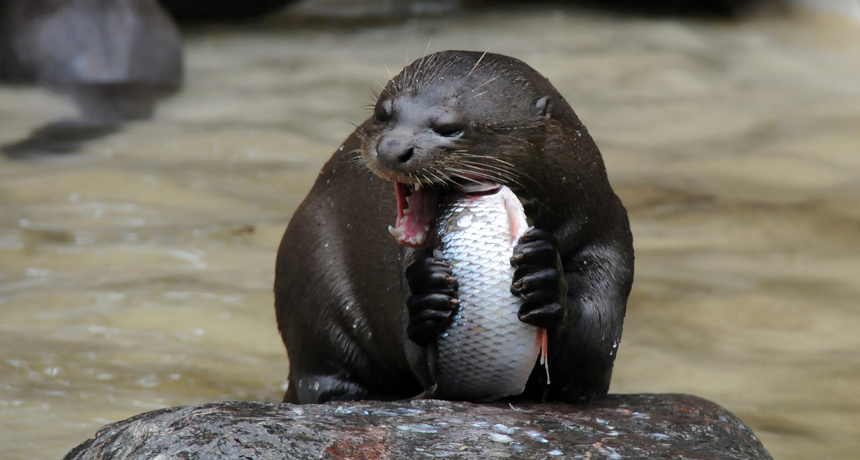Otters provide a lesson about the effects of dams

The giant river otter, one of South America’s largest carnivores, is endangered and has been on the decline in part because of habitat loss. But a new study finds that simply adding lots more water and shoreline won’t guarantee a huge increase in otter numbers.
Joachim S. Müller/Flickr (CC BY-NC-SA 2.0)
- More than 2 years ago
Hydroelectric dams can be massive modern marvels that provide electricity to thousands of people. They can also be environmental and cultural nightmares, when the lake that fills behind them drowns thousands of acres of land where animals and people once lived. That reservoir, though, might offer a decent tradeoff, providing lots of suitable habitat for a different set of animals.
But it’s not that simple, at least for endangered giant otters in the Balbina Hydroelectric Reservoir in Brazil. The otters live in one of the world’s largest hydroelectric reservoirs, but there aren’t as many of the animals as would be predicted by space alone. And that’s because the quality of habitat created matters as much as quantity, report Ana Filipa Palmeirim of Universidade Federal do Rio de Janeiro in Brazil and colleagues. They published their findings in the June Biological Conservation.
The Balbina dam was built on the Uatumã River in the Amazon rainforest near the northern border of Brazil in the 1980s. When water flooded the area behind the dam, it created a vast, shallow lake dotted with more than 3,500 islands. Water-covered area increased by a factor of more than 60, from 52.4 square kilometers to 3,287 square kilometers. Shoreline increased by almost ninefold, from 1,532 kilometers to 13,682 kilometers.
Palmeirim and colleagues regularly surveyed giant otters at dozens of locations across the lake from September 2001 to September 2010. They also radio-tagged a couple of otters in 2012. They used that data to estimate the population of otters in the lake. The researchers didn’t have good data for the otter population in the area before the lake formed, but a nearby tributary, the Pitinga River, provided a good proxy for the pre-lake habitat and otter population.
The researchers used that information to estimate that the otter population in the Balbina reservoir had doubled, from approximately 140 to 280 animals, in the 25 years since the dam was put in place. But with the increase in available habitat, there was room for 1,250 giant otters. And otter density fell, from 1.05 dens per kilometer to 0.24 dens per kilometer.
“The mismatch between habitat area and giant otter population expansion at the Balbina reservoir is unlikely to result from an inherent time-lag in otter population growth and dispersal,” the scientists write. Female otters start reproducing at age two, and there would have been around four generations of giant otters produced in the quarter-century since the reservoir was formed. That’s plenty of time for the population to have increased to more than 1,000 otters.
What the otters are missing is not suitable habitat but enough food. Giant otters eat about 10 percent of their body mass in fish every day. But a big lake does not ensure lots of fish. When the Balbina reservoir was first formed, it drowned more than 160 million trees. In the first few years of the reservoir’s existence, those trees provided a surge in nutrients that fed the food web. But that nutrient surge petered out, and fish diversity declined, a trend that’s been found in other Amazon hydroelectric reservoirs.
The Amazon is already home to 154 hydroelectric dams; 21 are now being constructed and another 227 are in planning stages. Often these dams create large, shallow lakes (like Balbina) that are huge sources of greenhouse gas emissions. And though they can bring much-needed electricity to remote regions, the amount of land drowned does not always match the amount of energy produced. Balbina, for instance, produces a mere 250 megawatts. (Brazil’s current electricity capacity totals 121,000 megawatts.)
With the world’s need for energy continuing to rise, it seems that nations are not going to stop building dams anytime soon. But the new otter research shows the need to consider the complexities in how ecosystems respond to these structures.






